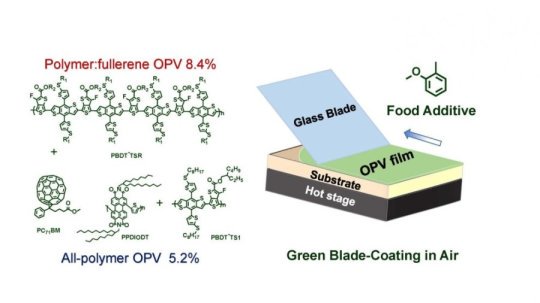An effective, semi-printed solar cells made with plastic has now been prepared without the utilization of environmentally hazardous halogen solvents. Such cells have been created with the use of food additive, O-MA as a solvent.

Scientists from the North Carolina State University and the Chinese Academy of Sciences have prepared an effective, semi-printed plastic based solar cell without the utilization of environmentally hazardous halogen solvents. It is possible to manufacture such solar cells at room temperature and can be used to serve multiple large-scale commercial production applications.
Plastic based solar cells, or other organic photovoltaic, are common because they are light in weight, inexpensive, transparent and flexible to create, thereby making them useful to serve numerous applications. Regrettably, the solvents comprising halogens utilized in their manufacture are a hindrance to serving large-scale commercial applications.
Such solvents are a major key to ensuring that the morphology of solar cells, structure, enhances it energy efficacy. But they are still environmentally hazardous. In addition to this, the utilization of such harsh chemicals needs a regulated environment that further adds to the total production expenditure.
Long Ye, a postdoctoral research expert in physics at NC State and head author of a paper illustrating the work, intended to identify if non-toxic solvents could offer equally effective morphology in the process of manufacturing. Ye and his team members introduced a proof of concept plastic solar cell that is semi-printed, and that uses O-methylanisole (O-MA) as the solvent. O-MA has popularly utilized flavouring agents in various sorts of foods and is non-toxic to the human beings.
The scientists utilized soft X-ray methods to investigate the morphology of solar cells. They identified that the O-MA based solar cells had similar morphology, device performance and crystalline features to such produced by halogenated solvents. The entire efficacy of solar cells rating was approximately 8.4 percent. Moreover, their cells could be manufactures through blade coating at suitable room temperature. Blade layering is a procedure that utilizes a glass blade to spread a sleek coating of the photovoltaic layer onto either a flexible or rigid substrate and the procedure is adjustable with big-scale commercial preparing.
“Two of the core requirements for bulk producing such solar cells are that particular cells that can be manufactured in the open air environment and that the procedure does not pose any sort of environmental or health hazards,” Ye says. “Hopefully such work can assist shift the route for printing solar cells in the ambient air.”
The experts are looking forward to witness the overall functionality of such cells and the various applications that it can serve on a large-scale basis. The researchers confirm that such cells offer better efficiency that implies that they have high-performance value. But the key is to look that whether such cells are suitable to serve residential applications or not. Since, these cells are environment-friendly, so it is also expected that it will bring better gains to the environment as a whole and will help combat the various troubles that are otherwise met with the regular cells.
Filed Under: News


Questions related to this article?
👉Ask and discuss on Electro-Tech-Online.com and EDAboard.com forums.
Tell Us What You Think!!
You must be logged in to post a comment.